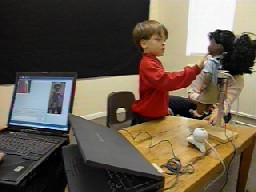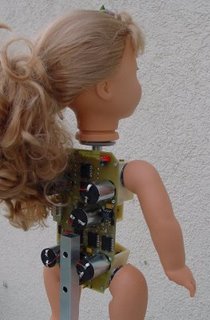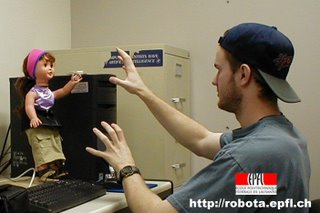U0205391 Beeharry Vishal
Toy robots have since long been viewed as entertainers for children. In the recent years, with the rise of technological motor-driven toys, a wide range of robot toys, for example AIBO from Sony and NeCoRo from Omron Corporation, have seen light. More humanoid robots, such as ASIMO from Honda and EMIEW from Hitachi, have also been added to the list of entertainment robots.

However, while being absorb with entertainment robots, one must not ignore the fact that robot toys can also be used for educational purposes. The AuRoRa project, started in 1998 in collaboration with different schools in the Hertfordshire (
University of Hertfordshire) and Essex areas, including Radlett Lodge School, Colnbrook School, and Bentfield Primary school, aims at using robot toys as an educational or therapeutic role for children with autism. One of the few robots used in the project is the Robota Doll. The picture on the left shows the first prototypes of Robota.
Robota Dolls are mini humanoid robots which have been developed specifically to serve as educational toys. These ‘dolls’ are sophisticated enough to be able to have complex interactions, such as speech, vision and body imitation, with humans. They have proved to be very useful to help children diagnosed with autism symptoms.
In case many may not be aware of autism, autism is a development disorder affecting 91 people in every 10,000. Although both the cause and cure of this disorder are currently unknown, their symptoms vary from children to children. Generally, children affected with the autism syndrome tend to have behavioral problems. They seem to be ‘cut off’ from the world and, acting as an observer, they avoid social contact while finding it difficult to participate in social situations. To help these children to have interactions with the people around them, they need to be taught such interaction ‘skills’ through adults. However, adults’ social behaviors are very delicate, elaborate and widely unpredictable (which often appear frightening to children with autism). Most autism children are more comfortable with mechanical toys. This is where the AuRoRa project comes into action.
The Robota Doll serves as a robotic platform to provide a safe, simplified (as compared to the real world) and predictable environment to familiarize these children with the socialization skills. Depending on the children’s abilities, the complexity of interaction can be varied. The pictures below show how the children can get involve in imitation and turn-taking games with the robots.


 Technology
Robota, being a humanoid doll, stands at 45 cm high. Her arms, legs and head are made from plastic components of a commercially available doll. The motors that drive the arms, legs and the head have each 1 DOF. She can detect and respond to touch through potentiometers to detect passive motion of its limbs and head. Various sensors (emitter/receiver, light detectors, etc,) can also be connected to Robota.
Technology
Robota, being a humanoid doll, stands at 45 cm high. Her arms, legs and head are made from plastic components of a commercially available doll. The motors that drive the arms, legs and the head have each 1 DOF. She can detect and respond to touch through potentiometers to detect passive motion of its limbs and head. Various sensors (emitter/receiver, light detectors, etc,) can also be connected to Robota. 

The best feature of Robota is that she can copy and imitate upward movements of the user’s arms and sideways movements of the user’s head when the latter is sitting close to the robot. Thus, the user can ‘play’ imitating and turn-taking games with Robota. Furthermore, machine learning algorithms allow Robota to learn from the user, for example, she can be taught a sequence of actions as well a vocabulary.
Some of other robots used in the AuRoRa project are:
(1) Mel Robot --> 38 cm long
--> 30 cm wide
--> 12 cm high
--> 8 IR sensors
--> 4 wheels
(2) Pekee Robot
--> 38 cm long
--> 30 cm wide
--> 12 cm high
--> 8 IR sensors
--> 4 wheels
(2) Pekee Robot
 --> Oval-shaped
--> 2 motorized wheels
--> 15 distance measuring sensors
--> Oval-shaped
--> 2 motorized wheels
--> 15 distance measuring sensors
In all the fields (assistive, security, home, entertainment, educational) robots are seen to have excelled beyond expectation. Though it may seem a distant future, the day where robots will be able to roam around on the streets, as “friends” with the humans, may soon arrive. To add on, who knows, maybe the scenes in the movie I,Robot can someday become reality.
To conclude, below are some quotes (fro movie I,Robot):
1. “Robots don’t feel fear, they don’t feel anything”.
2. “Can a robot write a symphony; can a robot turn a canvas into a beautiful masterpiece?”
3. “The future begins today (…) more sophisticated, more intelligent, and of course, three laws safe.”
4. “One day they’ll have secrets, one day they’ll have dreams”.
5. “We all have a purpose”.
 However, while being absorb with entertainment robots, one must not ignore the fact that robot toys can also be used for educational purposes. The AuRoRa project, started in 1998 in collaboration with different schools in the Hertfordshire (University of Hertfordshire) and Essex areas, including Radlett Lodge School, Colnbrook School, and Bentfield Primary school, aims at using robot toys as an educational or therapeutic role for children with autism. One of the few robots used in the project is the Robota Doll. The picture on the left shows the first prototypes of Robota.
However, while being absorb with entertainment robots, one must not ignore the fact that robot toys can also be used for educational purposes. The AuRoRa project, started in 1998 in collaboration with different schools in the Hertfordshire (University of Hertfordshire) and Essex areas, including Radlett Lodge School, Colnbrook School, and Bentfield Primary school, aims at using robot toys as an educational or therapeutic role for children with autism. One of the few robots used in the project is the Robota Doll. The picture on the left shows the first prototypes of Robota.

 Technology
Robota, being a humanoid doll, stands at 45 cm high. Her arms, legs and head are made from plastic components of a commercially available doll. The motors that drive the arms, legs and the head have each 1 DOF. She can detect and respond to touch through potentiometers to detect passive motion of its limbs and head. Various sensors (emitter/receiver, light detectors, etc,) can also be connected to Robota.
Technology
Robota, being a humanoid doll, stands at 45 cm high. Her arms, legs and head are made from plastic components of a commercially available doll. The motors that drive the arms, legs and the head have each 1 DOF. She can detect and respond to touch through potentiometers to detect passive motion of its limbs and head. Various sensors (emitter/receiver, light detectors, etc,) can also be connected to Robota. 

 --> 38 cm long
--> 30 cm wide
--> 12 cm high
--> 8 IR sensors
--> 4 wheels
(2) Pekee Robot
--> 38 cm long
--> 30 cm wide
--> 12 cm high
--> 8 IR sensors
--> 4 wheels
(2) Pekee Robot
 --> Oval-shaped
--> 2 motorized wheels
--> 15 distance measuring sensors
--> Oval-shaped
--> 2 motorized wheels
--> 15 distance measuring sensors 
3 comments:
u0300510 Chen Yanchang
Autism has always been linked with a social stigma for both the afflicted and parents of the afflicted. It's amazing how technology can be used to achieve some form of behavioural therapy for such children. Of course this is no substitue for actual human-to-human interaction but it does provide a safe controlled environment for autistic children who need alot of patience and tender loving care.
On another note, I was wondering if the development of such toys for interaction could eventually lead to a substitue for human-to-human interactions. Afterall, robots don't get angry, don't have mood swings and you don't have to please them. I wonder if future developments of such toys can lead to social problems later. But then again, we not quite at that stage that.
It was mentioned that the Robota can be taught a sequence of actions as well as vocabulary through machine learning algorithm, how is it being carried out? Does the user need to press some buttons or some words spoken by the user can activate the learning algorithm?
Take the case where the autistic user is comfortable with Robota. He could be comfortable with it as Robota is always following what he is doing. But after awhile, if this child is to put together with another child, will he feel comfortable given that the latter does not follow the ways that the former wants?
u0303893 Aung Myo Lwin Robot toys? It is interesting. I think for robot toys, we have to consider not only the technology involvements in the toy itself, we also have to consider other important effects it may incurred on the children who played with those toys. How these robot toys will assit in the development process of the kids, how these toys will affect their mind, their curiosity and so on. I think, there should have such research in those areas to provide more information for parents to decide whether they should buy such toy for their children.
Post a Comment